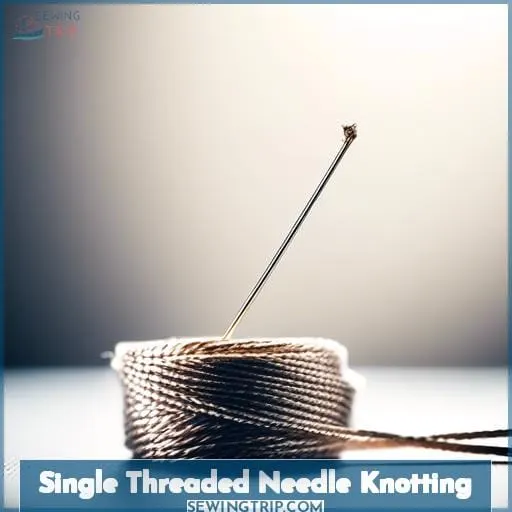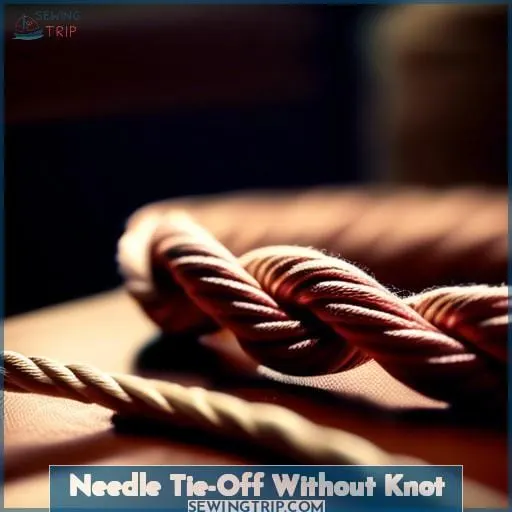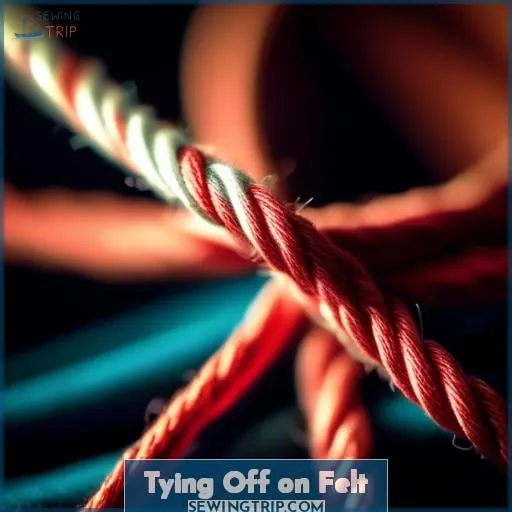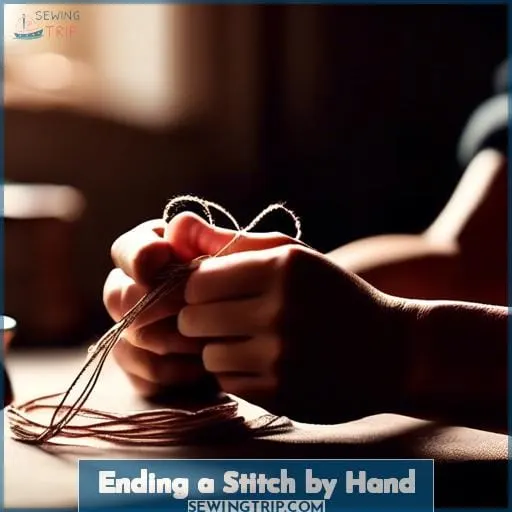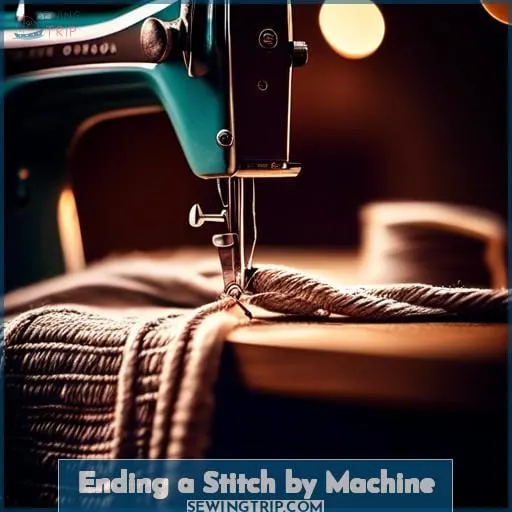This site is supported by our readers. We may earn a commission, at no cost to you, if you purchase through links.
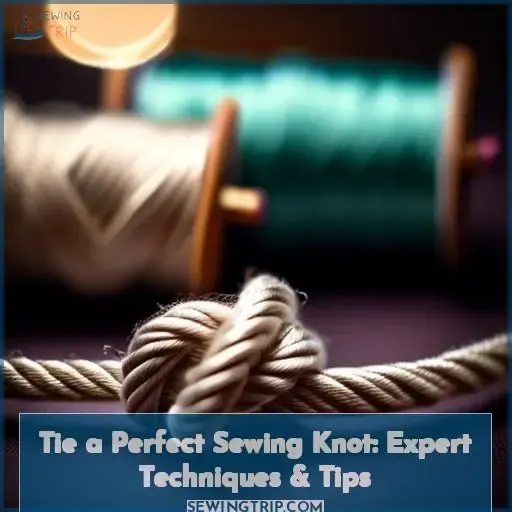 Mastering the art of tying a perfect sewing knot is essential for ensuring the longevity and durability of your sewing projects. Whether you’re finishing a seam, attaching a button, or securing a quilt, the right knot can make all the difference.
Mastering the art of tying a perfect sewing knot is essential for ensuring the longevity and durability of your sewing projects. Whether you’re finishing a seam, attaching a button, or securing a quilt, the right knot can make all the difference.
This guide will walk you through various expert techniques and tips for tying off your sewing projects with confidence. From double-threaded needle tie-offs to invisible finishes and everything in between, you’ll learn how to execute each method with precision.
Dive into the world of sewing knots and elevate your sewing skills to new heights.
Yes, to tie a sewing knot to finish, loop the thread to create a knot, hold it down with your finger near the fabric, and pull until it forms a knot in the desired location.
Table Of Contents
Key Takeaways
- To ensure a strong and durable finish when hand sewing, it’s recommended to use a double-threaded needle tie-off technique, which involves tying the two halves of the thread together and making three tight knots, with the initial knot slightly loose.
- For a neat and secure finish on felt, a standard knot is tied against the felt, and the needle is inserted adjacent to the knot and exits midway, allowing the thread end to retract and hide within the felt.
- When ending a stitch by machine, the backstitch technique is employed, sewing backward for a few stitches to lock the stitch in place, which is tested for security by gently pulling the fabric apart.
- General knotting techniques for a secure closure include making three tight knots and leaving a tail of thread after the last stitch, which is then trimmed for a tidy finish.
Double Threaded Needle Tie-Off
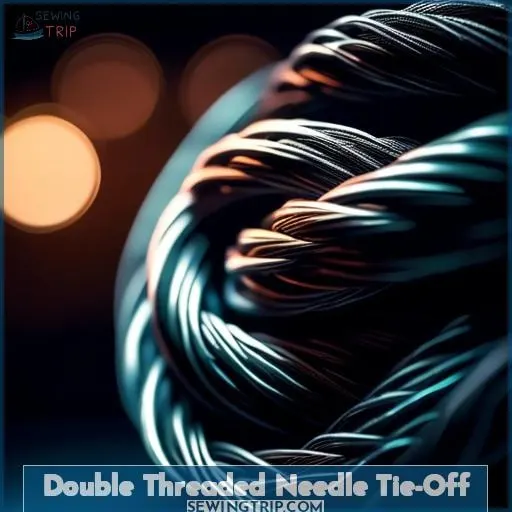
When it comes to finishing your sewing with a double threaded needle, it’s essential to secure your work properly.
You’ll want to cut your thread below the needle and tie the two halves together, ensuring you leave enough tail for easy handling.
After making three tight knots, with the initial one slightly loose, trim the excess thread to maintain a tidy finish.
This technique is straightforward yet effective, providing a strong closure to your stitching.
Cut and Knot Thread
First, always cut the thread below the needle and tie the two halves together for a secure finish.
- This method ensures a double needle join that’s robust, preventing your hard work from unraveling.
- It evokes a sense of accomplishment, knowing your knotted thread finish is both neat and durable.
- Mastery of this technique fosters a deep connection to the timeless art of sewing, enhancing your skill set.
Secure and Trim Excess
After completing your stitching with a double-threaded needle, it’s essential to ensure the durability of your work by securing the final knot and eliminating any unnecessary thread.
You’ll want to trim the excess close to the knot to maintain a tidy finish without adding bulk. This trim method enhances seam neatness, while exploring knot variations can introduce decorative elements, reinforcing both knot strength and the aesthetic appeal of your sewing projects.
Single Threaded Needle Knotting
When finishing your sewing with a single threaded needle, it’s crucial to secure your work with a proper knot.
To start, ensure you leave about three inches of thread after your last stitch; this gives you enough length to comfortably form a knot.
Loop the thread to create a preliminary knot, then press it down against the fabric with your finger to guide it into place as you tighten.
Once the knot is secured, trim the excess thread close to the fabric to maintain a clean finish.
This technique may require some practice, but it’s essential for a neat and secure end to your stitching.
Leave Thread Tail
When transitioning from the method of tying off with a double-threaded needle, it’s crucial to understand the nuances of working with a single-threaded needle, especially when it comes to knotting.
You’ll need to leave a sufficient tail of thread—about 3 inches—to facilitate the knotting process, ensuring you have enough slack to comfortably form and secure the knot without straining or tangling the thread.
This approach, while slightly more challenging for those new to sewing, becomes second nature with practice and allows for a secure finish to your sewing projects.
Loop and Tighten Knot
To loop and tighten the knot when using a single threaded needle for tying off in sewing, hold the loop against the fabric and pull the thread end to secure the knot.
Master knotting methods and looping techniques to manage thread and create decorative knots with precision.
Guide Knot and Trim
Your knot-tying technique is crucial for a secure finish in sewing. You’ll need to guide your knot close to the fabric’s surface and trim any excess thread to maintain a tidy seam.
- Ensure loop formation is snug against the fabric.
- Position knot placement accurately for seam strength.
- Integrate decorative knots for aesthetic appeal.
- Assess knot strength to prevent unraveling.
- Consider fabric thickness when tightening the knot.
Needle Tie-Off Without Knot
When finishing your sewing project, ensure a secure tie-off without a knot by making a tiny stitch through both fabric layers at the end of stitching.
Form a loop by pulling the thread and pass the needle through to flatten the loop, then trim the tail end for a neat finish.
This method, although visible, provides strength and reliability to your seams.
Make Tiny Stitch
In transitioning from the method of single-threaded needle knotting, another effective technique for securing your stitches without the visibility of a knot involves making a tiny stitch through both layers of fabric at the end of your stitching process.
Form and Flatten Loop
After making the tiny stitch through both fabric layers, you’ll notice a loop forming as you pull the thread. Pass your needle through this loop and tug gently until the loop lies flat against the fabric.
Trim Tail End
Once you’ve flattened the loop by pulling it tight, you’ll need to trim the tail end close to the fabric to ensure a neat finish.
- Revel in the satisfaction of invisible knotting, a testament to your finesse.
- Feel the pride in knot strength testing, ensuring lasting durability.
- Cherish the heritage of knot history with each snip, connecting past and present craftsmanship.
Tying Off on Felt
When working with felt, it’s essential to tie off your sewing with a technique that not only secures the thread but also conceals any loose ends for a clean finish.
To achieve this, tie a standard knot and position it snugly against the felt. Afterward, insert the needle adjacent to the knot and exit midway through the felt layers, pull the thread taut, and then trim it; the end will retract into the felt, effectively hiding it.
Knot Against Felt
With felt projects, you’ll want to tie off your thread by creating a regular knot right up against the material.
Mastering felt knot types enhances knot strength on felt, ensuring durability.
Decorative knotting can add flair, even on thick felt, minimizing knot visibility.
Hide Thread End
To conceal the thread end when working with felt, insert your needle right next to the knot and guide it out midway between the felt layers.
- Achieve a secure knot that remains unseen, ensuring a polished finish.
- Master hidden tie-offs for a seamless look.
- Explore decorative knot techniques to enhance your projects.
- Perfect the felt knot, a cornerstone of tidy handcrafting.
- Experiment with knot variations to find your signature style.
Snip and Shrink Thread
The process of tying off on felt involves a meticulous approach to ensure the thread end isn’t only secured but also concealed for a neat finish.
After completing your stitching on felt, the final step involves a simple yet effective technique: pulling on the thread end to tighten it and then snipping it close with scissors. This action allows the thread end to retract and shrink back into the felt, effectively hiding it from view and creating a clean, professional appearance.
This method is particularly beneficial when working with felt, as it prevents the thread ends from fraying or becoming loose, ensuring the durability of your project. Additionally, by hiding the thread ends, you maintain the aesthetic appeal of your felt creation, making this technique a valuable skill for both novice and experienced sewers alike.
Ending a Stitch by Hand
When ending a stitch by hand, it’s crucial to secure your sewing with a knot to prevent unraveling.
First, insert the needle under the nearest stitch to where you’ve finished sewing. This creates a loop through which you’ll insert the needle again, pulling tight to form a knot.
For thicker fabrics, you might need to repeat this process to ensure the knot is strong enough to hold.
This technique ensures your stitches stay intact and your sewing projects look professional and neat.
Insert Needle Under Stitch
Often, after tying off on felt, you’ll find yourself needing to end a stitch by hand, which you can easily do by inserting the needle under the nearest stitch.
- Adjust knot size variation for fabric thickness.
- Master needle insertion technique for precision.
- Experiment with decorative knotting using different thread types.
Form and Tighten Loop
You’ll need to leave a tail of thread about 3 inches long to ensure you have enough to form and secure the loop when ending a stitch by hand.
Loop positioning is crucial for knot appearance and strength, considering thread thickness and fabric suitability.
Repeat for Thick Fabric
When stitching on thick fabric by hand, reinforce your work with an additional knot.
This knotting sequence boosts knot strength, ensuring durability without compromising the fabric’s appearance.
Ending a Stitch by Machine
When ending a stitch by machine, it’s crucial to secure your work to prevent unraveling. A backstitch technique is a reliable method, where you sew backward for a few stitches at the start and end of your seam.
After sewing, lift the needle and presser foot lever to remove your fabric smoothly. Testing the stitch security by gently pulling the fabric apart ensures your stitches hold firm, providing peace of mind that your sewing project will withstand use and wear.
Backstitch Technique
- Stitch 3/4 inch from the edge to begin the backstitch technique for ending a stitch by machine.
- Press the reverse button.
- Sew 3-5 backstitches.
- Release the reverse button and continue stitching.
Backstitching ensures durability, suits various fabrics and threads, but requires practice.
Lift Needle and Foot Lever
After completing your stitching, use the handwheel to lift the needle to its highest position.
Raise the presser foot lever to remove your fabric from the sewing machine.
Ensure the needle elevation height and foot lever position allow for smooth fabric release.
Test Stitch Security
Having completed your backstitches, it’s crucial you test the stitch security to ensure the fabric won’t unravel.
- Gently pull the fabric apart, checking for testing strength and knot durability.
- Assess fabric compatibility; ensure stitches hold firmly without puckering.
- Examine thread thickness and the neatness of any decorative knots.
Frequently Asked Questions (FAQs)
How can I prevent my sewing knot from coming undone over time with frequent use or washing?
To ensure your sewing knot withstands frequent use and washing, make a secure knot by wrapping the thread around the needle multiple times before pulling it tight.
Additionally, consider applying a small amount of fabric glue to the knot for extra security, especially for materials prone to slipping.
Are there any specific knots recommended for different types of fabric, such as silk or denim?
For delicate fabrics like silk, use a fine, discreet knot like the slip or ladder stitch.
For tough fabrics like denim, opt for a sturdy square or backstitch knot to withstand wear and tear like a seasoned sailor’s rope.
What is the best way to tie a sewing knot when working with very fine or slippery threads?
For very fine or slippery threads, use a quilter’s knot for its small size and reliability.
Thread the needle, wrap the thread around it several times, slide the wraps down to form the knot, and trim the excess.
This method ensures a secure start or finish, especially with challenging materials.
Can I use a sewing knot to join two pieces of thread together, and if so, how?
Yes, you can join two pieces of thread together using a sewing knot.
Imagine weaving a bond as strong as Hercules himself between two threads.
First, lay the threads parallel and tie each end to the other.
Then, pull from both sides to bring the knots closer, creating a durable connection.
This technique is a testament to the strength and reliability of a well-tied knot, ensuring your sewing projects hold together with the tenacity of a warrior’s grip.
Is there a technique for tying a sewing knot that can be easily undone if I need to adjust the seam later?
To adjust a seam later, use a slip knot when finishing your sewing; it’s secure yet adjustable.
Create a loop with the thread, pass the needle through, and gently tighten without fully compressing the knot.
Conclusion
To perfect your sewing projects, mastering how to tie a sewing knot to finish is paramount.
Whether you opt for a double-threaded needle tie-off, a single-threaded knotting technique, or a knotless needle tie-off, each method offers its own unique benefits.
From securing seams to attaching buttons flawlessly, these expert techniques will elevate your sewing skills to new heights.
Dive into the world of sewing knots and watch your creations come to life with confidence and precision.

